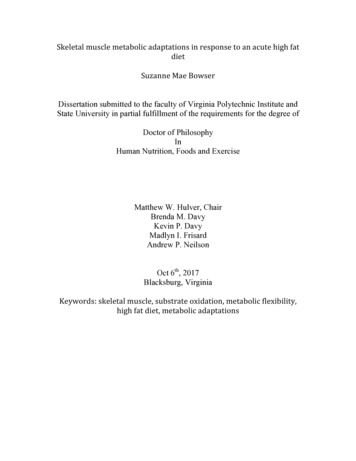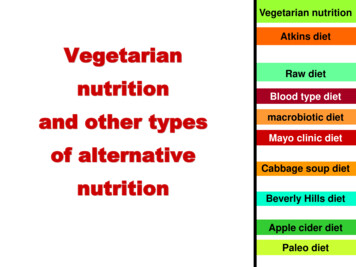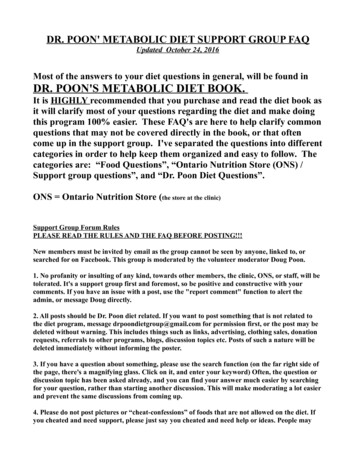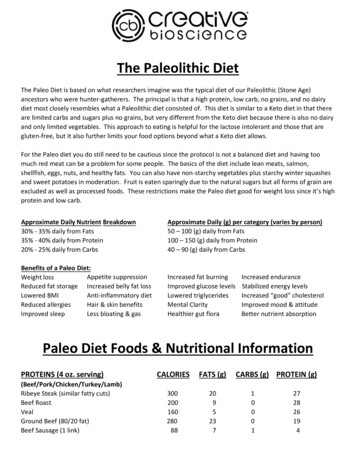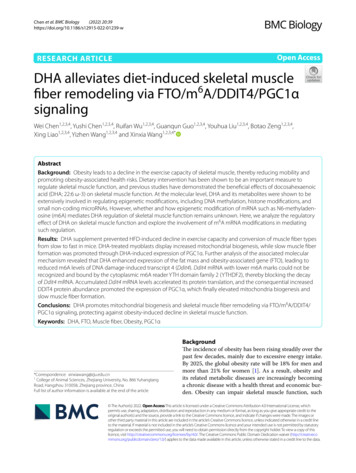
Transcription
(2022) 20:39Chen et al. BMC ESEARCH ARTICLEOpen AccessDHA alleviates diet-induced skeletal musclefiber remodeling via FTO/m6A/DDIT4/PGC1αsignalingWei Chen1,2,3,4, Yushi Chen1,2,3,4, Ruifan Wu1,2,3,4, Guanqun Guo1,2,3,4, Youhua Liu1,2,3,4, Botao Zeng1,2,3,4,Xing Liao1,2,3,4, Yizhen Wang1,2,3,4 and Xinxia Wang1,2,3,4*AbstractBackground: Obesity leads to a decline in the exercise capacity of skeletal muscle, thereby reducing mobility andpromoting obesity-associated health risks. Dietary intervention has been shown to be an important measure toregulate skeletal muscle function, and previous studies have demonstrated the beneficial effects of docosahexaenoicacid (DHA; 22:6 ω-3) on skeletal muscle function. At the molecular level, DHA and its metabolites were shown to beextensively involved in regulating epigenetic modifications, including DNA methylation, histone modifications, andsmall non-coding microRNAs. However, whether and how epigenetic modification of mRNA such as N6-methyladenosine (m6A) mediates DHA regulation of skeletal muscle function remains unknown. Here, we analyze the regulatoryeffect of DHA on skeletal muscle function and explore the involvement of m 6A mRNA modifications in mediatingsuch regulation.Results: DHA supplement prevented HFD-induced decline in exercise capacity and conversion of muscle fiber typesfrom slow to fast in mice. DHA-treated myoblasts display increased mitochondrial biogenesis, while slow muscle fiberformation was promoted through DHA-induced expression of PGC1α. Further analysis of the associated molecularmechanism revealed that DHA enhanced expression of the fat mass and obesity-associated gene (FTO), leading toreduced m6A levels of DNA damage-induced transcript 4 (Ddit4). Ddit4 mRNA with lower m6A marks could not berecognized and bound by the cytoplasmic m6A reader YTH domain family 2 (YTHDF2), thereby blocking the decayof Ddit4 mRNA. Accumulated Ddit4 mRNA levels accelerated its protein translation, and the consequential increasedDDIT4 protein abundance promoted the expression of PGC1α, which finally elevated mitochondria biogenesis andslow muscle fiber formation.Conclusions: DHA promotes mitochondrial biogenesis and skeletal muscle fiber remodeling via FTO/m6A/DDIT4/PGC1α signaling, protecting against obesity-induced decline in skeletal muscle function.Keywords: DHA, FTO, Muscle fiber, Obesity, PGC1α*Correspondence: xinxiawang@zju.edu.cn1College of Animal Sciences, Zhejiang University, No. 866 YuhangtangRoad, Hangzhou 310058, Zhejiang province, ChinaFull list of author information is available at the end of the articleBackgroundThe incidence of obesity has been rising steadily over thepast few decades, mainly due to excessive energy intake.By 2025, the global obesity rate will be 18% for men andmore than 21% for women [1]. As a result, obesity andits related metabolic diseases are increasingly becominga chronic disease with a health threat and economic burden. Obesity can impair skeletal muscle function, such The Author(s) 2022. Open Access This article is licensed under a Creative Commons Attribution 4.0 International License, whichpermits use, sharing, adaptation, distribution and reproduction in any medium or format, as long as you give appropriate credit to theoriginal author(s) and the source, provide a link to the Creative Commons licence, and indicate if changes were made. The images orother third party material in this article are included in the article’s Creative Commons licence, unless indicated otherwise in a credit lineto the material. If material is not included in the article’s Creative Commons licence and your intended use is not permitted by statutoryregulation or exceeds the permitted use, you will need to obtain permission directly from the copyright holder. To view a copy of thislicence, visit http:// creat iveco mmons. org/ licen ses/ by/4. 0/. The Creative Commons Public Domain Dedication waiver (http:// creat iveco mmons. org/ publi cdoma in/ zero/1. 0/) applies to the data made available in this article, unless otherwise stated in a credit line to the data.
Chen et al. BMC Biology(2022) 20:39as muscular atrophy, insulin resistance, and a shift fromslow to fast muscle fiber types, thereby reducing mobility and further increasing the health risks associated withobesity [2, 3]. Skeletal muscle comprises different musclefiber types, which can be divided into slow-twitch andfast-twitch fibers. The proportion of the different fibertypes determines contractile and metabolic propertiesof muscle tissue [4]. The transition of muscle fiber typefrom slow-twitch to fast-twitch caused by obesity leads tothe change of metabolism mode and the decrease of insulin sensitivity in skeletal muscle, which exacerbates thesystemic metabolic imbalance in turn [5]. Recent studieshave reported that exercise and nutrition regulation canreverse the transition of skeletal muscle fiber type causedby obesity and restore its exercise and metabolic function, so as to improve systemic metabolism [6, 7]. Therefore, it is meaningful to improve the function of skeletalmuscle in obesity by nutritional pathway.Recently, interest in the biological functions ofOmega-3 (ω-3) polyunsaturated fatty acids (PUFAs) hasescalated because of their various roles in health promotion and disease risk reduction [8]. DHA is an essentialfatty acid that is ubiquitous in marine animals and plantplankton [9]. Previous studies have reported that the bioactivities of DHA, such as improvement in brain function[10], antitumor activity [11], regulation of lipid metabolism [12], regulation of glucose metabolism [13], antiinflammatory effect [14], and improvement on exercisetraining and performance [15]. Increasing evidence alsosupports the beneficial effects of DHA on skeletal musclefunction, such as alleviating muscular atrophy [16], ameliorating endurance exercise capacity [17], and contributing in recovery from exhaustion [18]. However, there aresome contradictions in the current reports on the effectsof DHA on skeletal muscle under different physiological conditions, and its molecular mechanism needs to befurther explored.Studies on the molecular mechanisms have shownthat DHA and its metabolites are extensively involvedin regulating epigenetic modifications, including DNAmethylation, histone modifications, and small non-coding microRNAs [19]. However, how epigenetic modification mediates the regulation of DHA on skeletal muscleremains unclear. N 6-methyladenosine (m6A), the mostabundant mRNA modification in eukaryotes, has recentlyPage 2 of 19emerged as a significant post-transcriptional regulator. m6A methylation plays a crucial role in mediating manyimportant biological processes such as development,metabolism, and disease [20]. Considering that severalstudies have found that m6A regulates skeletal musclefunction, such as myogenesis [21, 22], lipid deposition[23], and muscle regeneration [24], we wanted to explorewhether DHA could influence m6A level in skeletal muscle and improve its function through RNA modification.ResultsDHA alleviates diet‑induced obesity and metabolicdysfunctionsTo assess the effect of DHA on skeletal muscle functionin a diet-induced obesity (DIO), we fed the mice withnormal fat diet (NFD), high-fat diet (HFD), or high-fatdiet supplemented with DHA (HFD DHA) for 10 weeks.We found that the final body weight of mice in HFDgroup was significantly higher than those fed NFD, andthis showed that our obesity model is successfully constructed (Fig. 1A). Mice fed with HFD DHA gained lessbody weight and fat accumulation than those in HFDgroup (Fig. 1A, B), while the food intake showed no significant difference (Fig. 1C). Consistent with the weightresults, the subcutaneous adipose tissue (SAT) andepididymal white adipose tissue (eWAT) of HFD DHAgroup were smaller and weighed less than those of HFDgroup, while there was no difference in liver weight(Fig. 1D). However, there was no significant difference in serum triglyceride content between HFD groupand HFD DHA group (Fig. 1E). Histological analysisshowed that mice had markedly reduced adipocyte sizeand liver lipid content in HFD DHA group comparedwith those in HFD group (Fig. 1F). To investigate theeffect of three dietary regimens on metabolism in mice,we next tested the glucose tolerance test (GTT) and insulin tolerance test (ITT) in three groups. After glucoseinjection, the blood glucose declined markedly faster inHFD DHA group when compared with those in HFDgroup (Fig. 1G). The results were also verified by thearea under curve (AUC) value of GTT (Fig. 1H). Similarresults were also shown in ITT data. Although DHA supplementation had no significant effect on ITT data, AUCresults showed that DHA increased insulin sensitivity inobese mice (Fig. 1I, J). These results above indicate that(See figure on next page.)Fig. 1 The dietary supplement of DHA prevents HFD-induced obesity. A Changes in body weight across time (n 8). B Representative picturesof mice in three groups. C The food intake in three groups (n 8). D Weight of subcutaneous adipose tissue (SAT) and epididymal white adiposetissue (eWAT) from mice in three groups, NS, not statistically significant (n 3 or 4). E Basic serum triglyceride level of mice in three groups (n 4). FRepresentative pictures of SAT and liver tissue from mice fed HFD and HFD DHA. Scale bar: 200 μm. G Intraperitoneal glucose tolerance test (GTT)(n 6), significant differences are shown between HFD and HFD DHA ( ). H Area under curve (AUC) of GTT. I insulin tolerance test (ITT) (n 6),significant differences are shown between HFD and HFD DHA ( ). J AUC of ITT (n 6). Statistical analysis was performed using one-way ANOVAwith time-repeated measurements (Fig. 1A, G, and I), two-tailed paired Student’s t tests (Fig. 1C–E, H and J)
Chen et al. BMC Biology(2022) 20:39Fig. 1 (See legend on previous page.)Page 3 of 19
Chen et al. BMC Biology(2022) 20:39DHA protects mice against HFD-induced obesity and therelated metabolic dysfunctions partly.DHA improves skeletal muscle functionunder the condition of HFDNext, we investigated the effects of DHA on the function of skeletal muscle. No significant differences wereobserved in morphology of various types of muscle inthree groups (Additional File 1: Fig. S1A). The HFD aloneresulted in weight loss in the mice soleus (SOL), whileadditional DHA supplementation under HFD conditionalleviated this muscle loss (Fig. 2A). By quantifying thehematoxylin-eosin staining (H&E) sections of the gastrocnemius (GAS) in mice (Additional File 1: Fig. S1B),we found that HFD caused muscle fiber atrophy in mice,while DHA reversed this phenomenon (Fig. 2B). Tofurther investigate the effects of DHA on skeletal muscle contraction properties, we then tested the exercisecapacity of mice. We found that DHA increased the timeof inverted screen test and the running distance (Fig. 2C,D), which indicated DHA could improve endurance exercise performance. It is well-known that skeletal muscleis composed of various types of muscle fibers, amongwhich, slow muscle fibers contain more mitochondria,and their metabolic pattern is dominated by oxidativephosphorylation. Therefore, the higher ratio of slow muscle fibers, the stronger the exercise endurance. To ascertain whether the altered endurance exercise performancewas associated with changes in muscle fiber types, wetested the muscle fiber types and gene expression associated with metabolic patterns. We found that DHAupregulated slow-twitch fiber-associated genes (Myh2,Myh7, Tnni1, and Mb), whereas it downregulated fasttwitch fiber-associated genes, including Myh4 and Tnni2(Fig. 2E). In addition, DHA also led to more mitochondria content in the skeletal muscle of mice as indicatedby mitochondrial DNA (mtDNA) level (Fig. 2F). In agreement with gene expression and mtDNA level, ATPasestaining showed that HFD caused a markedly decline ofslow-twitch muscle fiber proportion in GAS, while adding DHA under HFD condition increased the proportionof slow-twitch muscle fiber (Fig. 2G). The above resultssuggest that DHA improves skeletal muscle functionunder HFD, which may be due to the transition of glycolytic to oxidative muscle fibers induced.Page 4 of 19DHA supplementation changes the lipid compositionin muscle tissueIn order to further explore the mechanism of DHA supplementation affecting skeletal muscle function, we firsttested whether DHA supplementation changed the fattyacid content of muscle tissue in the early stage of gavage.Specifically, through targeted metabonomics, we analyzed the changes of medium and long-chain fatty acidsin mice gastrocnemius muscle. Principal componentanalysis (PCA) showed that mice fed with DHA showeddifferent composition of fatty acids in muscle from thecontrol group (Fig. 3A). Among these fatty acids, theconcentrations of 18 fatty acids changed (3 upregulatedand 15 downregulated) (Additional file 2), including theincreased DHA (C22:6N3) (Fig. 3B, C). So the administrated DHA was indeed digested and retained in themuscle tissues. In addition, DHA supplementation significantly increased the overall ω3 fatty acid concentration(P 0.01) and decreased the ω6 fatty acid concentrationthat nearly reached statistical significance (P 0.08 fortrend) (Fig. 3D). Although the concentrations of variousfatty acids have changed, DHA accounts for the largestproportion (Fig. 3E). Therefore, we speculated that DHAmay play a major role in regulating muscle function andfurther verified that in cell model.DHA increases aerobic oxidation and mitochondrialbiogenesis in C2C12To explore the intracellular mechanism for DHA-inducedfiber-type transition, we conducted studies in C2C12myoblasts with various concentrations of DHA. Cell proliferation assay showed that 100 μM or more of DHA wascytotoxic to C2C12 cells (Additional File 1: Fig. S2A). Totest the effect of critical concentrations of DHA on cells,higher concentrations of DHA (50, 100 μM) were addedto C2C12 myoblasts under differentiated medium supplemented with 2% horse serum. Bright field and H&Estaining showed that DHA with 50 or 100 μM inhibitedthe formation of myotubules and downregulated myosin heavy chain (MyHC) expression. At the early stage ofmyogenesis (2 days after differentiation), DHA treatmentalso inhibited the expression of Myod1 and Myog genes,which are important genes during myogenesis (Additional File 1: Fig. S2B-D). Due to its bidirectional differentiation potential, C2C12 can be induced into myocytesor adipocytes. Previous studies have shown that high(See figure on next page.)Fig. 2 DHA improves skeletal muscle function under the condition of HFD. A Weight of gastrocnemius (GAS), tibialis anterior (TA), extensordigitorum longus (EDL), and soleus (SOL) from mice in three groups (n 4 or 5). B Diameter distribution of muscle fibers in TA from mice in threegroups (μm) (n 500). C Inverted screen test of mice in three groups (n 8). D Running distance test of mice in three groups (n 8). E RelativemRNA expression of oxidative and glycolytic muscle fiber type markers measured by qPCR in GAS from mice in three groups (n 6). F Relativemitochondrial content of mice in three groups (n 6). G Metachromatic ATPase staining of GAS to detect type I muscle fibers (black). Statisticalanalysis was performed using two-tailed paired Student’s t tests
Chen et al. BMC Biology(2022) 20:39Fig. 2 (See legend on previous page.)Page 5 of 19
Chen et al. BMC Biology(2022) 20:39Page 6 of 19Fig. 3 Administration of DHA changed the lipid composition of muscle. A PCA of lipodomics from mice GAS in PBS and DHA group. B Heatmapsshowing normalized concentration of medium- and long-chain fatty acids in GAS of PBS and DHA group (n 4). C DHA concentration in GAS (fattyacid content per gram of GAS) (n 4). D Concentration of ω3 and ω6 fatty acids (FA) in GAS (n 4). E The composition of fatty acids with alteredconcentration (P 0.05) (n 4). Statistical analysis was performed using two-tailed paired Student’s t testsconcentrations of fatty acids increase the expressionof lipid-generating genes [25], so we hypothesized thathigh concentrations of DHA promoted the differentiation of C2C12 into adipocytes. Consistent with ourhypothesis, we found that high concentrations of DHAincreased intracellular lipid droplets even in myoblastdifferentiation medium (Additional File 1: Fig. S2E, F).Meanwhile, DHA treatment resulted in increased expression of genes associated with adipogenic differentiationin C2C12 cells, indicating that high DHA concentrations indeed promoted the differentiation of C2C12 intoadipocytes (Additional File 1: Fig. S2G). These results
Chen et al. BMC Biology(2022) 20:39contradict studies that DHA improves skeletal musclefunction in vivo, so we considered whether the higherconcentrations of DHA in cell culture would not correspond to the physiological concentration of DHA in vivo.Other studies have shown that the concentration of DHAPage 7 of 19in and skeletal muscle is about 5 μM [26], so we treatedC2C12 with low concentrations of DHA (5, 10 μM). Wefound that low concentrations of DHA had no effecton myoblast differentiation (Fig. 4A) or adipogenesis(Additional File 1: Fig. S2H, I), which was confirmed byFig. 4 DHA increases aerobic oxidation and mitochondrial biogenesis in C2C12. A Myotube formation of C2C12 myoblasts with DHA treatment(0, 5, 10 μM, 4 days). B ATP levels from early stage of myogenic differentiation (n 3, 48 h). C Representative images of slow muscle fiber (MyHC7)immunofluorescent staining in C2C12 myoblasts after 4 day differentiation. Scale bar: 200 μm. D qPCR measured different types of muscle fibergene expression (n 3, 48 h). E Western blot analysis of PGC1α expression from C2C12 treated with BSA or DHA (5, 10 μM). Different letters indicatesignificant differences between different doses of DHA treatment for 48 h (P 0.05). Statistical analysis was performed using one-way ANOVA
Chen et al. BMC Biology(2022) 20:39the related gene expression (Additional File 1: Fig. S2J).Intriguingly, low concentrations of DHA significantlyincreased ATP content in myoblasts (Fig. 4B). DHAtreatment increased the number of slow muscle fibersand the expression of oxidative and glycolytic musclefiber type markers (Fig. 4C, D). Since peroxisome proliferator-activated receptor-γ coactivator 1α (PGC1α) canregulate mitochondria biogenesis and muscle fiber transformation [27], we want to know whether DHA regulatedmitochondrial number and slow muscle fiber formationthrough PGC1α pathway. Western blotting assays confirmed that the expression of PGC1α was promoted afterlow concentrations of DHA treatment (Fig. 4E). Takentogether, these results showed that high concentrationsof DHA (50, 100 μM) inhibited myogenesis, while lowconcentrations of DHA (5, 10 μM) changed muscle fibercomposition. Further study showed DHA-mediated muscle fiber transformation might be through the PGC1αpathway.DHA reduces m 6A levels by increasing FTO proteinexpressionRecent reports have demonstrated that m6A is widelyinvolved in diverse eukaryotic biological processes,including cell differentiation [28, 29] and metabolicreprogramming [30, 31]. Nutrients can play their physiological functions by regulating m6A levels, such as epigallocatechin gallate [32], curcumin [33, 34], and NADP[35]. DHA previously has been shown to regulate DNAmethylation [36], which raises the question of whetherDHA function is also related to RNA methylation. Wefirst measured total m6A modified mRNA levels usingliquid chromatography-tandem mass spectrometry(LC-MS/MS) and found that DHA significantly reducedthe total m 6A levels in mRNA from both skeletal muscle tissues and myoblasts (Fig. 5A, B). m6A dot blot alsoshowed consistent results (Additional File 1: Fig. S2K.).By detecting the expression of major m6A methyltransferase and demethylase in muscle tissues and myoblasts,we found that DHA downregulated m 6A level mainlythrough promoting the protein expression of m6A demethylase FTO in vivo and in vitro (Fig. 5C–F).DHA increases PGC1α expression through FTOTo determine the role of FTO in DHA-induced skeletal muscle fiber switching in vivo, we first examinedthe expression profile of FTO during myogenesis. Theexpression level of FTO was increased during myoblast differentiation (Fig. 6A). SOL is known as a typicalslow-twitch muscle, whereas extensor digitorum longus(EDL) is a typical fast-twitch muscle, and FTO was highlyexpressed in slow muscle fibers in sync with PGC1αexpression (Fig. 6B). The above results showed that FTOPage 8 of 19may play a key role in myogenesis and muscle fiber typeremodeling. To further confirm this hypothesis, we firstvalidated that silencing of FTO substantially reduced theprotein expression of PGC1α (Fig. 6C). Loss of FTO alsoreduced the content of ATP and the number of mitochondria (Fig. 6D, E). Furthermore, siFto eliminated theincreased protein abundance of PGC1α in DHA-treatedcells (Fig. 6F). Taken together, our results demonstratedthat FTO mediated the positive regulation of DHA onPGC1α.FTO promotes PGC1α expression through DDIT4Next question, we need to answer is how FTO regulatesPGC1α. As we all known, FTO is one of the demethylasesof m6A, which promotes us to test if the m6A demethylase activity of FTO is necessary for promoting PGC1αexpression. We constructed FTO plasmid of wild-type(FTO-WT) and catalytic mutant FTOR96Q (FTOMUT). The impact of FTO-WT or FTO-MUT on cellular m6A level was identified by LC-MS/MS (Fig. 7A), whichproved their respective demethylase activity. Ectopicallyexpressed FTO-WT, but not FTO-MUT nor an emptyvector, significantly increased the protein expression ofPGC1α (Fig. 7B), indicating that the expression modulation of FTO on PGC1α protein is demethylase activitydependent. We then hypothesized that FTO regulatedprotein expression of PGC1α by increasing m 6A levels6of Ppargc1a. MeRIP-qPCR (m A-IP-qPCR) was used tomeasure the relative m 6A enrichment in Ppargc1a genes.Surprising, the relative m 6A enrichment of Ppargc1ahad no significant difference after Fto silence (Fig. 7C).Therefore, FTO did not directly regulate PGC1α expression through m 6A, and we assumed that there should6be another m A target gene that mediates the effect. Incombination with m6A sequencing data from previousstudies, Ddit4, a potential upstream Ppargc1a gene, containing m6A modification was screened [37]. The resultof MeRIP-qPCR showed that m 6A enrichment of Ddit4mRNA increased after Fto interference (Fig. 7D), whileWB and qPCR results showed that protein and mRNAexpression levels of DDIT4 also decreased after interfering Fto with siRNA (Fig. 7E, F). In muscle tissue, HFDincreased the m6A modification level of Ddit4 mRNAand decreased its gene expression (Additional File 1: Fig.S3A, B). Similarly, FTO-WT can increase DDIT4 protein expression, while FTO-MUT does not seem to havethis function (Additional File 1: Fig. S3C). These resultssuggest that Ddit4 may be the direct target gene of FTO.To further identify whether DDIT4 mediated the regulation of FTO on PGC1α expression, DDIT4 was depletedin C2C12 myoblasts. We found that silencing of Ddit4inhibited the protein and mRNA expression of PGC1α
Chen et al. BMC Biology(2022) 20:39(Fig. 7G, H). These data support that DDIT4 mediatedthe positive effect of FTO on PGC1α expression.YTHDF2 decreases DDIT4 protein expression by promotingmRNA decayOur next question was how m6A affected the DDIT4protein expression. Previous studies have shown that m6A modification exerts its function mainly dependingon the recognition by specific m 6A-binding proteins.In view of the negative correlation between m6A levels and protein expression of DDIT4, we assumed thatYTHDF2 might mediate DDIT4 translation via binding m6A site of the transcript. Compared with control cells,silence of Ythdf2 markedly promoted the protein andmRNA expression of DDIT4 (Fig. 8A, B). By RIP-qPCRassay, we further confirmed that Ddit4 directly interacted with YTHDF2 (Fig. 8C). mRNA stability analysisshowed that overexpression of YTHDF2 reduced thehalf-life of Ddit4 (Fig. 8D). Consistently, results abovesuggest that YTHDF2 regulates DDIT4 expression viamodulating mRNA stability Fig. 9.DiscussionObesity can cause a decline in contractile functionof skeletal muscle, thereby reducing mobility andpromoting obesity-associated health risks. Dietaryintervention is preferred as one of the most effective methods for improving skeletal muscle function,owing to its relatively easy operation and low costs. Ithas been found in previous studies the roles of various dietary nutrients including green tea, quercetin,curcumin, apigenin, DHA, and resveratrol in regulating skeletal muscle development, muscle mass, musclefunction, and muscle recovery [38]. Other groups havepreviously documented a role for DHA in regulatingthe organ development and energy metabolism [39].The goal of this research was to explore whether DHAcould protect against obesity-induced dysfunction ofskeletal muscle. In this study, we present several important advances in understanding the beneficial effects ofDHA on skeletal muscle function. First, DHA improvesskeletal muscle function by promoting muscle fibertype conversion from fast-twitch to slow-twitch inHFD. Second, DHA-induced muscle fiber type conversion is regulated by PGC1α-mediated mitochondrialPage 9 of 19biogenesis. Third, DHA increases the expression ofPGC1α mediated by DDIT4, which is controlled byFTO. These data provide a mechanism whereby DHAalters muscle fiber type and affords protection by m 6Amodification during HFD.Increasing evidence supports the beneficial effects ofDHA on skeletal muscle function [18]. Several studieshave reported that DHA-rich fish oil can modulate oxygen consumption during intense exercise and increasethe efficiency of oxygen use in skeletal muscles [40, 41].Other studies have shown that DHA supplementationcan ameliorate endurance exercise capacity, which maybe associated with increased expression of PGC1α inskeletal muscle that promotes mitochondrial biogenesis[15, 42]. However, there are some contradictions in thecurrent reports on the effects of DHA on skeletal muscleunder different physiological conditions, and its molecular mechanism needs to be further explored. At the sametime, a growing body of evidence suggests that epigenetics is one of the mechanisms by which nutrients andbioactive compounds affect metabolic properties, alsoknown as nutriepigenetic. DHA and its metabolites arealso extensively involved in regulating epigenetic modifications. In some ways, DHA needs to be methylatedto be metabolized further, so methyl groups need to beobtained directly or briefly from other methyl donors,such as S-adenosylmethionine (SAM)—the major methyldonors of m 6A [43]. So theoretically, DHA may affect6mRNA m A modification to regulate the physiologicalfunctions. In this study, we provided convincing evidencethat DHA markedly downregulated the level of m6A inskeletal muscle and myoblasts by promoting FTO expression in HFD.RNA modifications, particularly the most abundantmRNA modification, m 6A, have recently emerged ascritical post-transcriptional regulators of gene expression programs. m6A modification affects almost everystep in mRNA metabolism to some extent, includingmRNA stability, splicing, and translation. The majormechanism by which m 6A affects the fate of mRNAs is6by recruiting m A-binding proteins, in which YTHDF1stabilize mRNA and promote translation [44], whileYTHDF2 promotes degradation of m6A mRNAs bytargeting them to P-bodies [45]. In our study, the negative correlation between m6A methylation and protein expression of DDIT4 indicates that YTHDF2 may(See figure on next page.)Fig. 5 DHA reduces m6A levels by increasing FTO protein expression. A LC-MS/MS quantification of the m 6A/A in mRNA of GAS from mice fed HFD6or HFD DHA (n 3). B LC-MS/MS quantification of the m A/A in mRNA of myoblasts with different concentration of DHA (n 3). Western blotanalysis and quantification of major m 6A methyltransferase and demethylase expression in C, D skeletal muscle and E, F myoblasts (n 3). Differentletters indicate significant differences between different doses of DHA treatment for 48 h (P 0.05). Statistical analysis was performed usingone-way ANOVA (Fig. 5B, F) and two-tailed paired Student’s t tests (Fig. 5A, D)
Chen et al. BMC Biology(2022) 20:39Fig. 5 (See legend on previous page.)Page 10 of 19
Chen et al. BMC Biology(2022) 20:39Page 11 of 19Fig. 6 DHA increases PGC1α expression through FTO. A Western blot analysis of major m 6A methyltransferase and demethylase expression profileduring myogenesis (n 3). B Western blot analysis of FTO and PGC1α in fast-twitch muscle fiber (EDL) and slow-twitch muscle fiber (SOL) (n 3). CThe protein expression of PGC1α, D relative ATP content, and E mitogreen staining was tested in C2C12/siCtl and C2C12/siFto (n 3). Scale bar: 200μm. F Western blot analysis of FTO and PGC1α expression after DHA treatment and Fto silencing (n 3). Statistical analysis was performed usingtwo-tailed paired Student’s t testsmediate the degradation of DDIT4 mRNA. Our resultsdemonstrated that DDIT4 mRNA directly binds toYTHDF2 and is degraded by YTHDF2.To date, several studies have evaluated the effects of 6A modification on skeletal muscle and myoblasts.m m6A modification and m6A-related proteins change
Chen et al. BMC Biology(2022) 20:39Page 12 of 19Fig. 7 FTO promotes PGC1α expression through DDIT4. A LC-MS/MS quantification of the m6A/A in mRNA of control, FTO-WT, and FTO-MUToverexpressing cells (n 3). B Western blot analysis of FTO and PGC1α expression in control, FTO-WT, and FTO-MUT overexpressing cells (n 3).C, D Methylated RNA immunoprecipitation (MeRIP)-qPCR analysis of m6A levels of Ppargc1a and Ddi
Results DHA alleviates diet‑induced obesity and metabolic dysfunctions To assess the eect of DHA on skeletal muscle function in a diet-induced obesity (DIO), we fed the mice with normal fat diet (NFD), high-fat diet (HFD), or high-fat diet supplemented with DHA (HFD DHA) for 1


